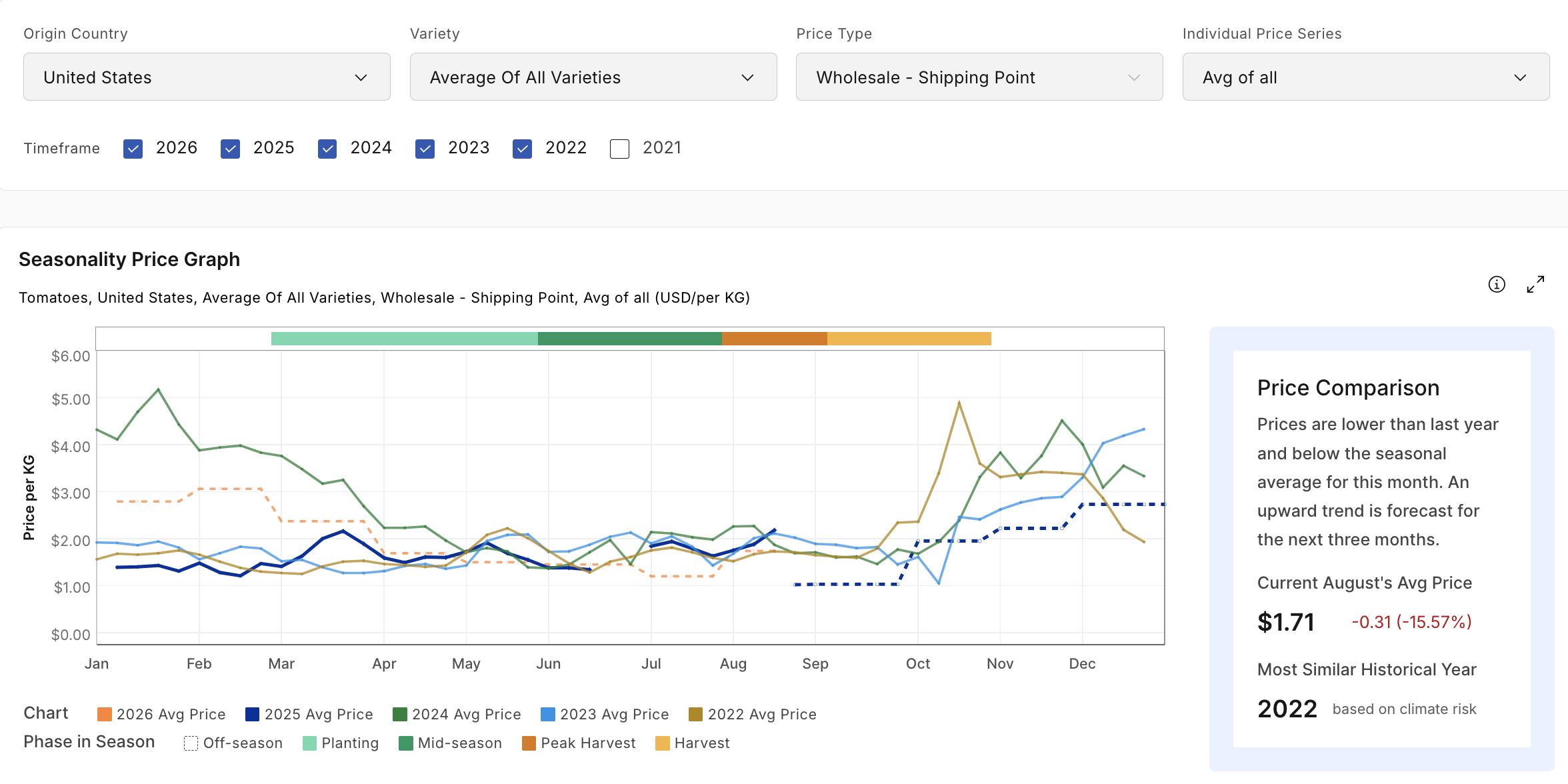Introducing Price Seasonality on Helios: Your New Tool for YoY Commodity Price Trends
We’ve just launched a new feature on the Helios platform: the Price Seasonality tab. It’s designed to give procurement teams a sharper understanding of how commodity prices move throughout the year, and how those trends compare across multiple years.
What It Does
The Price Seasonality tab lets users compare weekly and monthly prices across the past five years, side by side, in a single visual. For each commodity, you’ll see how pricing has evolved month by month, year by year, layered with forecasts and seasonal production phases (like planting or peak harvest). It is available for all prices we currently have on the CommodiTrack platform!
Unlike our standard pricing charts, which focus on recent and upcoming movements, this view is specifically built to support long-term, seasonal price analysis. It’s ideal for sourcing teams looking to plan purchases, evaluate timing, or make supplier decisions with better historical context.
Context, Timing, and Trends—All in One View
Commodity prices are rarely random. They respond to seasonality, supply cycles, weather extremes, and demand surges. But spotting those patterns, especially over several years, used to require piecing together disconnected charts or downloading raw data.
The Seasonality tab makes it easy to see how prices behave over time. You can compare the same calendar month across multiple years, align price movements with key points in the growing season, and quickly tell whether a spike is part of a normal harvest pattern—or something out of the ordinary. No need to jump between reports, tabs, or different pages or piece things together manually. It’s all in one place, built to show how timing, seasonality, and climate trends influence pricing.
A Quick Tour of the Seasonality Tab
Key elements:
Year-over-year price comparison: View prices for the current, upcoming and past 5 years all on on the same chart
Production season overlays: See when planting, mid-season growth, peak harvest, and harvest occur and how they line up with prices
Forecasts & historical analogs: Identify upcoming trends and the most similar past year based on climate risk
Granularity by variety & geography: Zoom in on specific countries, varieties, and price types. Every price series we have is available for analysis.
It’s also fully connected to the original pricing page—every price series we add going forward will appear in both views.
A Real-life Example - Tomatoes
Tomatoes are a great example of how the Seasonality tab brings pricing patterns into focus. It’s incredible to see how different seasonal price trends can be even for small changes like a change in variety, country, or price type. Let’s look at how different varieties trends can be, even in the same commodity and country combination.
All Varieties (U.S.): August 2025 prices are down 15.6% vs. 2024 and below the seasonal average, though they’re expected to rise into the fall.
Grape Tomatoes: Prices are up 4.4% YoY and currently above trend, but forecasted to decline.
Roma Tomatoes: Slightly below last year, but well above the seasonal norm, with a strong increase expected through October.
You can also toggle to Mexico, where the harvest season peaks in January–March. In 2026, prices during this period are significantly higher than in previous years, before easing in the summer off-season. This level of detail is especially useful for importers managing cross-border timing and supply.
Designed for Smarter Timing
Whether you’re locking in contracts or timing spot purchases, understanding the historical highs, lows, and seasonal behavior of a crop gives you an edge. With price seasonality broken out by variety and geography, you get a clearer picture of what’s happening, both now and in years past. This new tab reflects our goal at Helios: to bring context, clarity, and climate-awareness to every procurement decision. You’re no longer reacting to numbers in isolation—you’re working with history, forecasts, and agronomic insight, all in one place.






